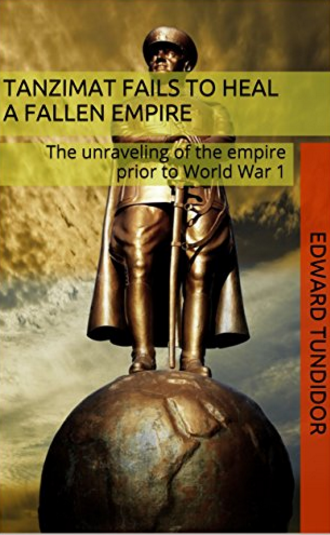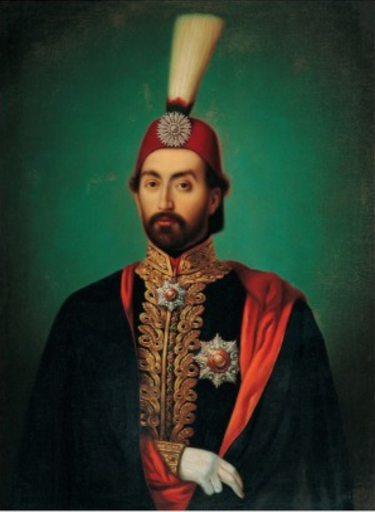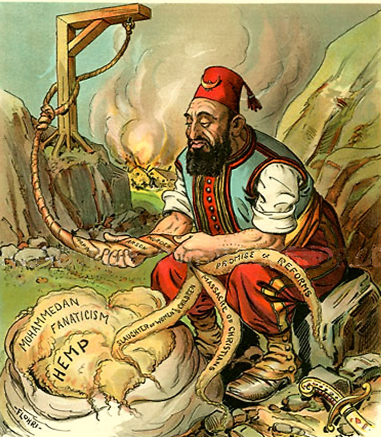(Book) - Tanzimat fails to heal a fallen Empire by Edward Tundidor - Part 1
This 3 part series is my book that uncovers the final years of the Ottoman Empire.

In part 1 : Introduction
Chapter 1
Chapter 2
Table of Contents
• Chapter 1: Implementing the Tanzimat reforms
• Chapter 2: The economic and social construct of the empire
• Chapter 3: Western Education and Civil Rights in the Ottoman Empire
• Chapter 4: The decay of the empires power due to nationalism
• Chapter 5: Nationalism sparks revolution
• Chapter 6: The World War 1 genocide of the Armenian subjects
Introduction
In the 19th century, the Ottoman Empire was going through a phase orchestrated by a series of sultans to establish reforms to propel the Empire into a position of modernization, to compete with the rest of Europe. The damage of the old model of Ottoman government coupled with the loss of territory, and insufficiently industrializing, and a declining economy left the Empire at a disadvantage from an international standpoint. Domestic issues intensified with ethnic and religious discrimination on the part of Muslims against its non-Muslim population, which led the Sultan to propose liberal reforms to end old traditions of racial segmentation. Pressure from foreign and domestic constituents forced the Ottoman state to implement the Tanzimat reforms in 1856 as a call to stop the designation and distinctions of religious and ethnic hierarchy among its citizenry. This initiative would allow for all ethnic groups and religious designations to the identified as Ottoman citizen-subjects of the Empire rather than their traditional designation as second-class citizens of the Empire. The Tanzimat reforms were a failed attempt at mending social anguish within the Ottoman state, with the empire entrenched in a climate of social fragmentation between Muslim and non-Muslims. Contrary to the scholarly theory the watershed moment in the Ottoman Empire occurred when nationalistic sentiments were ignited by the Tanzimat reforms, further dividing the populace in the 19th century, which in turn shaped 20th-century politics built on the Western ideals that consequently led to genocide and territorial dismemberment of the Empire.
Chapter 1
The Ottomans decided to reform themselves dramatically after the invasion of Napoleon Bonaparte in 1798-99 causing immense death and destruction which led to bureaucracy and aristocracy to call for change. Imperial bureaucrats of the Ottoman Empire, who have studied European culture and infrastructure wanted the Sultan to implement “dramatic reconstruction of not only the military, but of basic political and economic institutions” to resurrect the Empire from its dormant state and make it a competing force against other European nations. In this endeavor, the Ottoman bureaucracy for the first time was trying to implement a political system of equality to all Ottoman subjects regardless of their ethnic or religious background. Sultan Mahmud II sought to establish a resurgence of the Empire by fostering a monolithic ideal of nationalism by orchestrating “citizenship and membership” of all Ottoman subjects regardless of ethnicity and religious background to develop a “common Ottoman political identity” among its diverse populace. In the first step of reform, bureaucrats wanted to improve its military and security of the empire; they also wanted to suspend any threats to the initiative of Ottoman modernization. In 1826, Sultan Mahmud II decided to abolish the Janissary corps and institute a western style military police known as the gendarmeries who helped broaden the centralization of reforms in Ottoman provinces with limited solvency, and the where the bureaucratic rule continued the friction between ethnic groups.
There was a constant feeling of despotism among the Christian population during the period of reforms causing them to advocate for “laws protecting the life and property of Ottoman Christians” and the banishment of the brutal violence and unspeakable acts of torture against all non-Muslim subjects. Ottoman Christians also pushed for the same civil rights and protection of laws that Muslims had; they also called for the economic expansion for Christians and improved academic opportunities as well.

After the 1839 Gulhane edict under the rule of Sultan Abdülmecid I, the Supreme Council of Judicial Ordinances decides to revamp the penal code and establish laws that put Christians on the equal playing field with Muslim in legal issues to foster the equality among the entirety of the Ottoman populace. From 1840 to 1851 the Empire made sweeping changes to the legal system to reconstruct the criminal justice system similar to countries in Western Europe. The Ottoman bureaucrat’s political initiatives “possessed deep roots of antecedents in Ottoman classical” as the construct of the political structure strictly adheres to Islamic ideology rather than a multi-ethnic approach to the reform of the law. The motivation of the Ottoman government regarding the 1851 penal code was to fulfill promises of the 1839 Gulhane edict to “assist in the maintenance of public order” and stop future possibilities of “tyranny and corruption” among its bureaucrats on a national and local level. The Penal Codes of 1848 and 1851 were intended to breed ethnic cohesion; rather it was just a “continuation of the standardization and rationalization of executive and Islamic criminal law and practice” extending this mindset to the courts as well, further the dispelling the notion of integrated Western principles of law within the Empire. Many observers in the European political arena felt that the Ottoman Turks had an embedded intolerance for Christian influence. The Ottoman Turks did not want to adopt western modification and modernization because it would change the Islamic foundation of the Empire as the centerpiece of the Ottoman Empire’s political construct. European observers explain that the Ottoman Turks were also willing to channel embedded traits of violent fanaticism to preserve Islamic ideals within the modernization effort. This provocation led international observers to view the Empires fate inevitably “bound to destroy itself because of its vices” which perpetually creates a wedge between them in their non-Muslim population. The traditional Islamic political construct only further fragments the development of multiethnic cohesion.

Chapter 2
After the Tanzimat reform (1856), the mid-19th-century European view of the Ottoman political process is perceived as a slow-moving approach towards reforms that characterize them as “superficial imitators.” A stagnant Ottoman political process was the prevailing view of the Empire well into the Young Turk Revolution of 1908. The Ottoman Empires primary focus was reforming its military into a more modernized unit while reinforcing their rule with an iron fist approach towards minorities. To build this modern military force, the Ottoman Empire started a census based on a broad scope and accurate numbers of who would join, and an idea of how many non-Muslims would be authorized to pay a tax, since they banned for military service. In 1856, the Ottoman Empire established tax farming as a means to fund the modernization of its military which helped to further the divide between Muslim and non-Muslim communities by “increase the burden of the peasants” who paid a substantial portion of the tax revenue. The central government further debased the economic stability of their most improvised groups, by levying a variety of taxes and tolls as a means obtaining funding for military exemption. The taxation of non-Muslims particularly Christians was established by the central government to create a quasi- “separate but equal economic status” which seemed like a social injustice among the non-Muslim populace. The Ottoman central government was setting the standard that it is a privilege to live among Muslims in the Empire.
Although the Tanzimat reforms called for the inclusion of all non-Muslims in all facets of the public spectrum, rather this was not the case because Islamic ideas were deeply rooted in the wide fabric keeping the fragmentation of the Ottoman population in place. It is especially tough for non-Muslim subjects to reach the “higher echelons of the social system” prolonging the obligations of reform, and further reinforcing ethnic segmentation in the Empire. The only way to ascend of the social strata of the Ottoman Empire was to be a part of the Sultan’s administration which was not an option for non-Muslims. Many observers have made the claim that the divide between ethnic, religious groups within the Ottoman Empire fall in conjunction with “socioeconomic and political affiliations” further widening the gap for non-Muslims to obtain political equality. With these socioeconomic and policy differences between ethnic and religious groups of the Empire, those in the non-Muslim community faced with economic instability had to “reconstruct their ethnic character” when confronted with economic challenges caused by “forces of industrialization and nationalism”. This adaptive survival mechanism used by the non-Muslim subjects of the Empire as they associate with other like-minded individuals was to create a structure of cultural cohesion outside the Islamic construct. Regardless if it was from a political or economic standpoint within the Ottoman Empire “equality was simply against the natural order of things” and traditional values that follow the status quo were the norm rather than the exception during the age of reform. An example of this ongoing issue is seen in Anatolian cities calling for Egyptian ruler Mehmed Ali to be the foil that puts a stop to Europeans meddling in Ottoman political affairs of the Tanzimat reforms. Furthermore, the Ottoman bureaucracy felt political and social justice for non-Muslims was nonproductive on a local level. The climate on the local level among the Muslim subjects regarding the Tanzimat reforms was quite hostile and toxic, with the sentiment after the decree among the Muslim populace was a feeling that they relinquished the sacred rights given to them by their forefathers through war and conquest. As ethnic segmentation continued to be a pillar of the social construct within the Ottoman Empire, that reinforced racial intolerance making political unity nonexistent. While the pressure internationally was mounting in the mid-to-late 19th century upon the Ottoman populace to change their oppressive political, social construct, there was an ever-growing need for jihad in the name of the “preservation of Islamic faith” because the tolerance of Western ideals was infringing on Islamic centralization of government.
Part 2 coming tomorrow! Notes and Souces provided in Part 3
Tanzimat fails to heal a fallen Empire: Is available now on Amazon.com for $0.99 use this link for your purchase. ( Kindle format Only) http://amzn.to/2fVWZkS

If you enjoyed my work

All proceeds from upvotes on this post are going to more Steem Power.